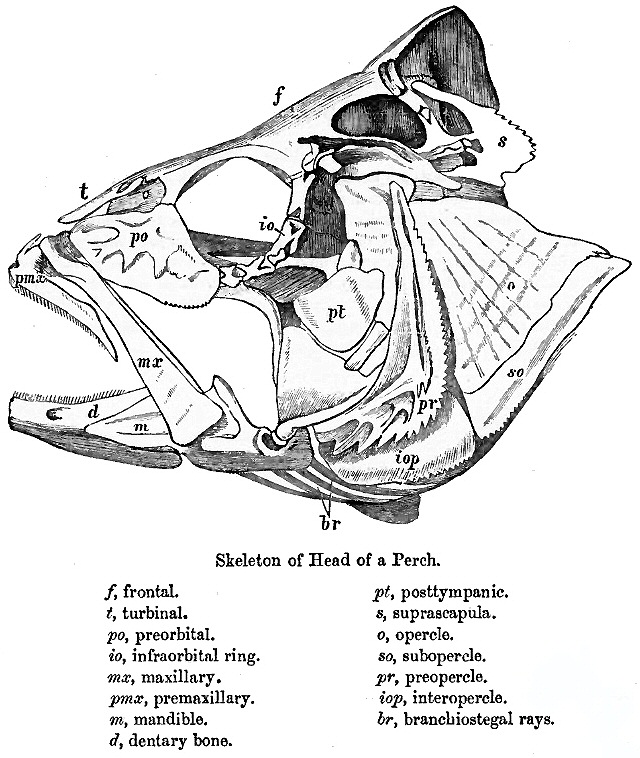|
Otocephala
Otocephala is a clade of ray-finned fishes within the infraclass Teleostei that evolved some 230 million years ago. It is named for the presence of a hearing (otophysic) link from the swimbladder to the inner ear. Other names proposed for the group include Ostarioclupeomorpha and Otomorpha. The clade contains Clupeiformes (herrings) and Ostariophysi, a group of other orders including Cypriniformes (minnows and allies), Gymnotiformes (knifefish), and Siluriformes (catfish). Otocephala may also contain Alepocephaliformes (slickheads), but as yet (2016) without morphological evidence. The clade is sister to Euteleostei which contains the majority of bony fish alive today. In 2015, Benton and colleagues set a "plausible minimum" date for the origin of Crown group, crown Otocephala as about 228.4 million years ago. They argued that since the oldest locality for any diversity of stem teleosts is the Carnian of Polberg bei Lunz, Austria, whose base is 235 million years old, a rough est ... [...More Info...] [...Related Items...] OR: [Wikipedia] [Google] [Baidu] |
Teleostei
Teleostei (; Ancient Greek, Greek ''teleios'' "complete" + ''osteon'' "bone"), members of which are known as teleosts (), is, by far, the largest group of ray-finned fishes (class Actinopterygii), with 96% of all neontology, extant species of fish. The Teleostei, which is variously considered a Division (zoology), division or an infraclass in different taxonomic systems, include over 26,000 species that are arranged in about 40 order (biology), orders and 448 family (biology), families. Teleosts range from giant oarfish measuring or more, and ocean sunfish weighing over , to the minute male anglerfish ''Photocorynus spiniceps'', just long. Including not only torpedo-shaped fish built for speed, teleosts can be flattened vertically or horizontally, be elongated cylinders or take specialised shapes as in anglerfish and seahorses. The difference between teleosts and other bony fish lies mainly in their jaw bones; teleosts have a movable premaxilla and corresponding modifications ... [...More Info...] [...Related Items...] OR: [Wikipedia] [Google] [Baidu] |
Clupei
Clupeomorpha is a superorder of ray-finned fish which belongs to the clade Otocephala. Represented today only by the diverse, economically-important order Clupeiformes (containing herrings, anchovies and allies), it was formerly even more diverse, with the extinct order Ellimmichthyiformes also known. Fossil records of this group date back to the Berriasian/Valanginian boundary, with the genus ''Ellimmichthys''. Classification Clupeomorpha contains the following taxa: *Genus '' Beurlenichthys'' de Figueiredo & Gallo, 2004 *Genus '' Leufuichthys'' Gallo ''et al.'', 2011 *Genus '' Ornategulum'' Forey, 1973 *Genus '' Scombroclupea'' Kner, 1863 *Order Ellimmichthyiformes Grande, 1982 ** Family Armigatidae A. M. Murray & M. V. H. Wilson, 2013 ** Family Sorbinichthyidae Bannikov & Bacchia, 2000 ** Family Paraclupeidae Chang & Chou, 1974 (= Ellimmichthyidae Grande, 1982) * Order Clupeiformes Goodrich, 1909 ** Suborder Denticipitoidei Grande, 1982 *** Family Denticipitidae Cl ... [...More Info...] [...Related Items...] OR: [Wikipedia] [Google] [Baidu] |
Ellimmichthyiformes
The Ellimmichthyiformes, also known as double-armored herrings, are an Extinction, extinct Order (biology), order of Actinopterygii, ray-finned fish known from the Early Cretaceous to the Oligocene. They were the sister group to the extant true herrings, Alosidae, shad and Anchovy, anchovies in the order Clupeiformes, with both orders belonging to the suborder Clupeomorpha. A highly successful group throughout the Cretaceous, they were found worldwide and are known to have inhabited both marine and freshwater habitats. They appear to have been a largely marine group for most of their history, with the first freshwater lineages appearing during the Late Cretaceous. Shortly after the origin of the Ellimmichthyiformes in the Early Cretaceous, the Mediterranean Sea, Mediterranean portion of the Tethys Ocean appears to have been a major center of diversification for them, as the majority of fossils of this group are known from there. Following this, they saw an explosion in diversity ... [...More Info...] [...Related Items...] OR: [Wikipedia] [Google] [Baidu] |
Ostariophysi
Ostariophysi is the second-largest superorder of fish. Members of this superorder are called ostariophysians. This diverse group contains 10,758 species, about 28% of known fish species in the world and 68% of freshwater species, and are present on all continents except Antarctica. They have a number of common characteristics such as an alarm substance and a Weberian apparatus. Members of this group include fish important to people for food, sport, the aquarium industry, and research. Taxonomy The superorder is divided into two series, Anotophysi and Otophysi. However, in older literature, Ostariophysi was restricted only to the fish that are currently classified under Otophysi. Otophysi was coined in 1970 by Rosen and Greenwood to separate the traditional Ostariophysians from the added Gonorynchiformes. The superorder is classified below: *Series Anotophysi ** Gonorynchiformes, about 107 species *Series Otophysi (Euostariophysi) ** Cypriniformes ( minnows and allies), a ... [...More Info...] [...Related Items...] OR: [Wikipedia] [Google] [Baidu] |
Anotophysi
Ostariophysi is the second-largest superorder of fish. Members of this superorder are called ostariophysians. This diverse group contains 10,758 species, about 28% of known fish species in the world and 68% of freshwater species, and are present on all continents except Antarctica. They have a number of common characteristics such as an alarm substance and a Weberian apparatus. Members of this group include fish important to people for food, sport, the aquarium industry, and research. Taxonomy The superorder is divided into two series, Anotophysi and Otophysi. However, in older literature, Ostariophysi was restricted only to the fish that are currently classified under Otophysi. Otophysi was coined in 1970 by Rosen and Greenwood to separate the traditional Ostariophysians from the added Gonorynchiformes. The superorder is classified below: *Series Anotophysi ** Gonorynchiformes, about 107 species *Series Otophysi (Euostariophysi) ** Cypriniformes (minnows and allies), about 4 ... [...More Info...] [...Related Items...] OR: [Wikipedia] [Google] [Baidu] |
Ray-finned Fish
Actinopterygii (; ), members of which are known as ray-finned fish or actinopterygians, is a class of bony fish that comprise over 50% of living vertebrate species. They are so called because of their lightly built fins made of webbings of skin supported by radially extended thin bony spines called '' lepidotrichia'', as opposed to the bulkier, fleshy lobed fins of the sister clade Sarcopterygii (lobe-finned fish). Resembling folding fans, the actinopterygian fins can easily change shape and wetted area, providing superior thrust-to-weight ratios per movement compared to sarcopterygian and chondrichthyian fins. The fin rays attach directly to the proximal or basal skeletal elements, the radials, which represent the articulation between these fins and the internal skeleton (e.g., pelvic and pectoral girdles). The vast majority of actinopterygians are teleosts. By species count, they dominate the subphylum Vertebrata, and constitute nearly 99% of the over 30,000 extant ... [...More Info...] [...Related Items...] OR: [Wikipedia] [Google] [Baidu] |
Atlantic Menhaden
The Atlantic menhaden (''Brevoortia tyrannus'') is a North American species of fish in the herring family, Alosidae. Atlantic menhaden are found in North Atlantic coastal and estuarine waters from Nova Scotia south to northern Florida. They are commonly found in all salinities of the Chesapeake Bay and Mid-Atlantic water. They swim in large schools that stratify by size and age along the coast. Younger and smaller fish are found in the Chesapeake Bay and southern coastline while older, larger fish are found along the northern coastline. Characteristics Atlantic menhaden are silvery coloured fishes characterized by a moderately compressed body and a black spot on their shoulder behind their gill openings. They can reach a size of approximately 15 inches. Biology Diet The Atlantic menhaden is a filter feeder; it collects food by filtering water through modifications of the branchial apparatus (gill arches and gill rakers). Its diet depends on the size of their gill rakers, whi ... [...More Info...] [...Related Items...] OR: [Wikipedia] [Google] [Baidu] |
Eschmeyer's Catalog Of Fishes
Catalog of Fishes is a comprehensive on-line database and reference work on the scientific names of fish species and genera. It is global in its scope and is hosted by the California Academy of Sciences. It has been compiled and is continuously updated by the curator emeritus of the CAS fish collection, William N. Eschmeyer. The taxonomy maintained by the Catalog of Fishes is considered authoritative and it is used as a baseline reference for instance by the broader global fish database FishBase, which involves cross-references to the Catalog's information for all accepted taxa. the searchable catalogue contains entries for about 58,300 fish species names, about 33,400 of which are currently accepted (valid), and for some 10,600 genera (5,100 valid). [...More Info...] [...Related Items...] OR: [Wikipedia] [Google] [Baidu] |
John Wiley & Sons
John Wiley & Sons, Inc., commonly known as Wiley (), is an American Multinational corporation, multinational Publishing, publishing company that focuses on academic publishing and instructional materials. The company was founded in 1807 and produces books, Academic journal, journals, and encyclopedias, in print and electronically, as well as online products and services, training materials, and educational materials for undergraduate, graduate, and continuing education students. History The company was established in 1807 when Charles Wiley opened a print shop in Manhattan. The company was the publisher of 19th century American literary figures like James Fenimore Cooper, Washington Irving, Herman Melville, and Edgar Allan Poe, as well as of legal, religious, and other non-fiction titles. The firm took its current name in 1865. Wiley later shifted its focus to scientific, Technology, technical, and engineering subject areas, abandoning its literary interests. Wiley's son Joh ... [...More Info...] [...Related Items...] OR: [Wikipedia] [Google] [Baidu] |
California Academy Of Sciences
The California Academy of Sciences is a research institute and natural history museum in San Francisco, San Francisco, California, that is among the largest List of natural history museums, museums of natural history in the world, housing over 46 million specimens. The academy began in 1853 as a learned society and still carries out a large amount of original research. The institution is located in Golden Gate Park on the West Side (San Francisco), West Side of San Francisco. Completely rebuilt in 2008, the academy's primary building in Golden Gate Park covers . In early 2020, before the COVID-19 pandemic, the California Academy of Sciences had around 500 employees and an annual revenue of about $33 million. Governance The California Academy of Sciences, California's oldest operating museum and research institution for the natural sciences, is governed by a 41-member board of trustees who are nominated and chosen by the California Academy of Sciences Fellows. The Academy Fello ... [...More Info...] [...Related Items...] OR: [Wikipedia] [Google] [Baidu] |
Ricardo Betancur-R
Ricardo is the Spanish and Portuguese cognate of the name Richard. It derived from Proto-Germanic ''*rīks'' 'king, ruler' + ''*harduz'' 'hard, brave'. It may be a given name, or a surname. People Given name *Ricardo de Araújo Pereira (born 1974), Portuguese comedian *Ricardo Arjona (born 1964), Guatemalan singer *Ricardo Arona (born 1978), Brazilian mixed martial artist *Ricardo Ávila (born 1997), Panamanian footballer *Ricardo Bierhals (born 1990), Brazilian footballer * Ricardo Bralo (1916–?), Argentine long-distance runner *Ricardo Bombine Pimentel (born 1978), Brazilian musician *Ricardo Bueno Fernández (1940-2015), Spanish politician * Ricardo Busquets (born 1974), Puerto Rican swimmer *Ricardo Cardeno (born 1971), Colombian triathlete *Ricardo Carvalho (born 1978), Portuguese footballer *Ricardo Cortez (1900-1977), American actor *Ricardo Darín (born 1957), Argentine actor * Ricardo da Silva (born 1980), Cape Verdean-Portuguese footballer *Ricardo Esgaio, Portuguese ... [...More Info...] [...Related Items...] OR: [Wikipedia] [Google] [Baidu] |




